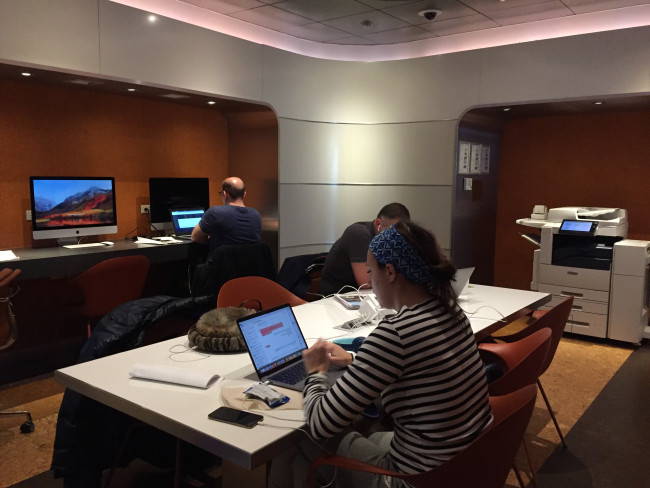12 questions to ask before renting a luxury apartment in New York City

This two-bedroom, two-bath rental at 259 Bowery is asking $12,000 a month with no fee.
You’re patting yourself on the back. You’ve figured out that thanks to all the new luxury rental buildings that have gone up in New York City recently, you don’t have to plunk down a small fortune (aka a down payment) in order to live in a nice building with great amenities (cue the light bulb flash overhead). You can rent in a luxury building instead.
And that means you can enjoy things like a heated, indoor lap pool in a state-of-the-art fitness center, a screening room, entertainment lounge, game room, catering kitchen, and increasingly, a pet spa. And those are just the basic amenities you can likely expect. Newer high-end rentals have co-working spaces, rock climbing walls, golf simulators and sound studios and much more.
You could probably spend all day describing the fun stuff in your new apartment building. But you should stay focused.
“People get excited about amenities they rarely wind up using,” says Phil Lang, co-founder of The Agency (a Brick Underground partner). "It's important to stay practical."
Lang says that new arrivals to the city and their parents are most susceptible.
“Don’t allow yourself to be swayed by amenities you won’t use anyway. If you’ve never stepped foot in a gym before, you probably won’t start now," Lang says. "And if you don’t have a pooch to pamper, the pet spa is useless."
Just because your financial commitment is not as deep as an apartment owner doesn’t mean you should take signing a lease at a luxury building lightly. You’re still going to be paying a pretty penny, and there are plenty of things that make renting in a luxury building different. Here are some questions to ask before you take the plunge into the salt-water lap pool, or what it is that’s blowing your mind.
[Editor's note: This story previously published in May 2018. It has been updated with new information for June 2019.]
1. Do you have to pay extra for the gym?
Sure, the building’s gym rivals your local Equinox, but if it isn’t included in the rent, you might end up paying more than you would otherwise.
If, on the other hand, having a gym just an elevator ride away from home sounds perfect to you, check it out at the time of day you would normally want to use it to see if there's a wait for your favorite exercise equipment.
And if your new building’s on-site gym charges a membership fee, it’s also important to understand the terms, says Andrew Sacks, an agent at Citi Habitats. He suggests asking if you have the flexibility of going month-to-month, or do you have to lock yourself into a year term? "Also, some buildings charge by the apartment," he says, "and others per person. Be sure to clarify when taking a tour.”
2. How's the cellphone service in those sky-high apartments?
Spotty cell service can be a problem for those who dwell several dozen stories above the earth. Find out if the building offers a technological workaround, like a cellular base station that connects calls through a broadband network. And ask how much extra it will cost you.
3. Is the location convenient enough?
Landlords and management companies often compensate for an awkward location—say, three avenues from the nearest subway line—by piling on amenities and charging luxury rents. Work out what your commute will actually look like, and keep your eye on the prize.
Keep location a top priority. You'll use the screening room/golf simulator/roof deck far less if you are commuting far. If the building runs a shuttle bus to the nearest subway line, find out how frequently it runs, and whether it will be operational on weekends.
Keep in mind that new ferry routes are also a commuting option and can broaden your search. Kateryna Pachashynska, leasing manager at 63 Wall Street, points out that the building is within walking distance of eight different subway lines, as well as a NY Waterway ferry stop.
4. Are guarantors accepted?
Luxury buildings don't come cheap. If your annual income (or your and your roommates' income combined) doesn't add up to 40-50 times the monthly rent, will you be allowed to call in some reinforcements? (In the past, some renters were allowed to put down larger security deposits to get an apartment, but deposits have been capped at one-month’s rent under the new rent reforms).
Because of these changes, guarantors are going to become much more prevalent for people who have poor credit or do not qualify by income, says Lang. Many landlords will accept a guarantor who makes at least 80 times the monthly rent and lives in the tri-state area.
Sacks of Citi Habitats also suggests asking if the landlord is strict about requiring guarantors to be in the tri-state area, or accepts them from other states as well.
“Also, many high-net-worth individuals (and potential guarantors) don’t want to provide tax returns for privacy reasons,” Sacks says. “Can they show a multiple of the annual rent in liquid assets through bank statements to avoid providing tax information?”
If you're short on wealthy relatives, see if the building accepts Insurent, an institutional lease guarantor (and Brick sponsor) that guarantees leases for a fee of about a month's rent.
5. What’s the story with storage space?
Your luxury building is more likely than other types of rentals to offer storage space, bike parking, stroller storage, and even wine storage. But is there a wait list? And is the price included in the rent?
Looking for the perfect luxury rental in the perfect neighborhood? Insist on a washer/dryer, swimming pool, balcony or indoor parking? Want a building that's flexible about guarantors, pets, or temporary walls—or will welcome you with a free month's rent? Place your search into the capable hands of The Agency, a tech-savvy real estate brokerage that's helped hundreds of Brick Underground readers find their ideal NYC apartments. Bonus: The agents at The Agency are not only a delight to deal with, they will charge a broker's fee of 10 percent of a year's rent on open listings instead of the usual 12 to 15 percent if you sign up here.
6. Are you guaranteed a spot in the garage?
If you own a car, you may be sick of playing the alternate side parking game every morning and moving your car accordingly. But even if your new building has a garage, don’t just assume that you’re guaranteed a spot. Many places have waiting lists a mile long, with people waiting months, if not years, for a parking space.
Find out if you have a chance of getting into the parking structure anytime soon, or if you’ll simply be circling a different neighborhood in search of a spot after your move. Valet parking is also available at a number of buildings—for an additional charge.
Sacks points out that many buildings charge different rates for sedans vs. SUVs for parking in their on-site garages, so get a quote for your specific vehicle type.
“Also, if you drive a luxury or exotic brand, be sure to ask what the rate is for your particular model is before showing up with your car. Some garages will try charging you more if they see you’re ‘riding in style,’” he says.
7. What is the temporary wall policy?
In recent years, safety concerns have led some major New York landlords to disallow temporary walls in favor of bookshelves or partial walls that don’t reach the ceiling. So if you can’t swing the apartment's rent without a roommate, or afford a true two-bedroom, find out the building’s official policy on carving out your own space. You can also consult Brick Underground's list of landlords who allow temporary walls.
8. Is that the actual rent I'll pay each month?
Often with new development rental buildings, owners will offer you a deal to encourage you to sign a new lease. This way, landlords can fill higher-priced apartments without actually dropping the rent. A deal could mean no fee, or a month or two “free.” But be careful—the apartment with free months may be listed under the “net effective” or “advertised rent,” which is not the actual rent you will pay each month.
That’s because the net effective rent is calculated by taking the total amount of concession, dividing it by the term of the lease then deducting that amount from the monthly asking rent. But you’re not actually paying that reduced amount. Typically you get you get a free month at the beginning or end of your lease, and the rest of month you are paying the higher “gross rent.” And when it’s time to renew, any rent increase will be based on your gross rent.

Brick Underground's
Gross Rent Calculator
What's this?
Some New York City landlords offer a free month (or more) at the beginning or end of a lease. The advertised rent is the net effective rent. The net effective rent is less than the amount you will actually have to pay --- known as your gross rent --- during your non-free months.
Brick Underground's Gross Rent Calculator enables you to easily calculate your gross rent, make quick apples-to-apples comparisons between apartments and avoid expensive surprises. All you'll need to figure out your gross rent is 1) the net effective rent, 2) the length of your lease, and 3) how many free months your landlord is offering. [Hint: Bookmark this page for easy reference!]
To learn more about net effective versus gross rents, read What does 'net effective rent' mean?.
If the landlord is offering partial months free, enter it with a decimal point. For example, 6 weeks free rent should be entered as 1.5 months.
So it’s important to figure out what your gross rent is. You can do the math, or you can plug your net effective rent, length of the lease and the number of free months in Brick Underground’s Gross Rent Calculator. Because no one should ever be surprised by how much rent they owe.
9. Is the building technology-enabled?
Websites like BuildingLink and ClickPay allow residents to make maintenance requests and send instructions to doormen at any time of the day or night. They also can email you when packages have been delivered. Lang recommends finding out whether your desired building is signed up for such an account, or stuck in the Stone Age using sticky notes to track deliveries.
10. Are dogs allowed?
Luxury rentals tend to be more dog-friendly than many rental buildings (at least if your dog is under 50 pounds. If not, read this). You will probably need to sign a pet rider—an addendum to your lease that lists the number and type of pets you own—and pay a pet deposit. You may also have to ride the service elevator when you're walking your dog, so ask about any special rules that apply.
“Pet-centric amenities have become a no-brainer during design development and building programming,” says Zoe Elghanayan, vice president of TF Cornerstone. You’ll find pet washrooms, in-house pet care concierge services and organized doggy play sessions at TF Cornerstone buildings, she says. “We are even hosting a pet adoption event for our Long Island City residents this July,” Elghanayan says.
Many luxury buildings permit smaller pets (under 50 pounds), but prohibit larger animals or exotic pets that might frighten other residents.
Some buildings also charge “pet rent” in addition or in lieu of a pet deposit. Typically this charge ranges between $25-$75 per month—and is tacked on to your monthly bill,” Sacks says.
11. Do they take credit cards?
Many large buildings owned by national real estate investment trusts accept credit cards. Before you hand yours over, ask whether you will be charged a "convenience fee" for putting your rent on plastic. And then weigh whether getting points is worth that extra cost.
12. Can I get a deal?
In addition to getting a concession like a month or two free or no fee, another way to potentially score a deal is to agree to—or propose— a longer lease term.
“Some landlords are more generous with those who sign a two-year lease, or one that expires during the busy summer season,” says Sacks. “You may be able to secure a month (or more) of free rent if you are willing to be flexible with the length of your tenancy.”
You Might Also Like




























